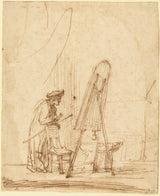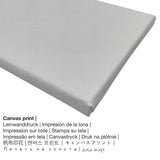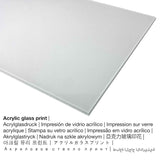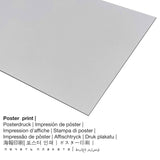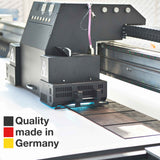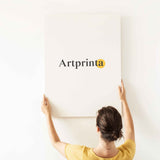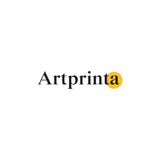Rembrandt van Rijn, 1630 - Onye na-ese ihe na Studio ya - mbipụta nka mara mma
Ụtụ gụnyere. Mbupu gbakọrọ na ndenye ọpụpụ.
Nhọrọ akụrụngwa ngwaahịa gị
Anyị na-enye ụdị nha na ihe dị iche iche maka ngwaahịa ọ bụla. Ị nwere ike ịhọrọ nha na ihe kachasị amasị gị n'ime nhọrọ ndị a:
- Mbipụta kanvas: A canvas direct print is a printed cotton canvas mounted on a wooden frame. Besides, canvas creates a soft, positive impression. A canvas print of this work of art will let you turn your art print into a large size artpiece like you know from galleries. Canvas Prints have the advantage of being low in weight, meaning that it is quite simple to hang the Canvas print without the support of any wall-mounts. That is why, canvas prints are suited for any kind of wall.
- Poster (akwa akwa akwa): Our poster print is a UV printed canvas with a fine surface texture. Please bear in mind, that depending on the size of the canvas poster print we add a white margin of something between 2-6cm around the print to facilitate the framing with your custom frame.
- Mbipụta ọla (aluminium dibbond): An Aluminium Dibond print is a print material with an outstanding effect of depth. A non-reflective surface creates a fashionable impression. The Direct Print on Aluminum Dibond is your excellent introduction to prints manufactured with aluminum. For the Aluminium Dibond option, we print your chosen artpiece right onto the surface of the white-primed aluminum material. The colors of the print are luminous in the highest definition, details appear crisp and clear. The direct print on Aluminum Dibond is one of the most popular entry-level products and is a contemporary way to showcase fine art prints, since it puts the viewer’s attention on the image.
- Bipụta na enyo acrylic: The print on acrylic glass, often named a print on plexiglass, will change your favorite original work of art into beautiful wall decoration. Besides, the acrylic glass art print is a good alternative option to canvas and dibond prints. The artwork will be custom-made thanks to state-of-the-art UV print machines. It makes sharp and rich colors. With an acrylic glass fine art print contrasts and granular artwork details become identifiable thanks to the precise tonal gradation. The acrylic glass protects your chosen art replica against sunlight and external influences for many years.
Nkwupụta iwu: We try whatever we can in order to describe the products as accurate as possible and to display them visually. Nevertheless, the pigments of the print materials, as well as the printing might diverge to a certain extent from the presentation on the device's monitor. Depending on the settings of your screen and the condition of the surface, colors may not be printed as realisitcally as the digital version. Since all our are processed and printed manually, there may also be slight deviations in the motif's size and exact position.
Ozi nkowa mgbakwunye sitere na webụsaịtị ihe ngosi nka (© - Ụlọ ihe ngosi nka nke J. Paul Getty - Ụlọ ihe ngosi nka nke J. Paul Getty)
Using only pen and ink, which shows every mistake, Rembrandt Harmensz. van Rijn created the space and volume of an artist's studio with a spare use of line. He drew the easel and the painting first, as the point of reference for the artist and the other objects. He later added the perspective lines that converge beyond the right edge of the paper; they served to confirm his intuition about the correct construction of objects in space. The heavier reinforcing lines at the bottoms of the chair and easel indicate adjustments to their placement.
Some scholars have labeled this drawing as a self-portrait in which Rembrandt himself views a panel from a distance, developing a mental image of the whole picture before he begins to work. Alternatively, other scholars argue that it depicts Rembrandt's friend and fellow Leiden artist Jan Lievens, who began his pictures by making a rough sketch in paint directly on the canvas.
The 17th narị afọ ndị na-ese ọrụ nka nwoke onye na-ese ihe Rembrandt van Rijn n'afọ 1630. Ihe osise a tụrụ nha: 20,5 x 17 cm (8 1/16 x 6 11/16 na). Pen and brown ink onye na-ese ihe na Europe ji mee ihe dị ka onye na-ese ihe. Ọ bụ nke nchịkọta nke Ụlọ ihe ngosi nka nke J. Paul Getty, nke bụ akụkụ nke ntụkwasị obi J. Paul Getty na bụ otu n'ime ụlọ ọrụ nka kacha ukwuu n'ụwa niile. Ọ na-achọ ịkpali ọchịchọ ịmata ihe gbasara, na ịnụ ụtọ na nghọta nke nka a na-ahụ anya site n'ịchịkọta, ichekwa, igosipụta, na ịkọwa ọrụ nka nke àgwà pụtara ìhè na mkpa akụkọ ihe mere eme.. Site n'ikike nke: Ụlọ ihe ngosi nka nke J. Paul Getty (ikike - ngalaba ọha).Ihe kredit nke ọrụ nka bụ: . N'elu nke ahụ, nhazi n'ime Eserese format ma nwee oke onyonyo nke 1: 1.2, nke pụtara na ogologo bụ 20% mkpụmkpụ karịa obosara. The painter Rembrandt van Rijn was an artist, whose style was primarily Baroque. The European artist lived for a total of 63 years - born in 1606 na Leiden wee nwụọ na 1669 na Amsterdam.
Data ndabere gbasara nka
| Aha nka: | "An Artist in His Studio" |
| nhazi ọkwa: | sere |
| Otu sara mbara: | nka ochie |
| Narị afọ nka: | 17th narị afọ |
| Afọ nka: | 1630 |
| Afọ nka: | 390 afọ |
| Agba na: | pen na ink aja aja |
| Nha izizi (ọrụ nka): | 20,5 x 17 cm (8 1/16 x 6 11/16 na) |
| Ụlọ ihe ngosi nka / mkpokọta: | Ụlọ ihe ngosi nka nke J. Paul Getty |
| Ebe ebe ngosi nka: | Los Angeles, California, Njikota Obodo Amerika |
| website: | Ụlọ ihe ngosi nka nke J. Paul Getty |
| Ụdị ikike nka: | ngalaba ọha |
| Site n'aka: | Ụlọ ihe ngosi nka nke J. Paul Getty |
Banyere akụkọ
| Nkewa edemede: | ọrụ mgbidi |
| Usoro mmeghari: | dijitalụ mmeputakwa |
| Usoro mmepụta: | Mbipụta UV ozugbo |
| Mmalite ngwaahịa: | Germany |
| Stockdị ngwaahịa: | a na-achọ |
| A na-atụ aro iji ngwaahịa eme ihe: | ihe osise nka, nka mgbidi |
| Ndozi onyonyo: | usoro eserese |
| Njikwa oyiyi: | 1: 1.2 |
| Nsonaazụ nke akụkụ onyonyo: | ogologo bụ 20% mkpụmkpụ karịa obosara |
| Nhọrọ ihe: | Mbipụta iko acrylic (nwere ezigbo mkpuchi iko), mbipụta ọla (aluminium dibond), mbipụta akwa akwa, mbipụta akwụkwọ mmado (akwụkwọ kwaaji) |
| Nhọrọ nha nha mbipụta kanvas (akwa akwa na etiti ihe ndọtị): | 50x60cm - 20x24", 100x120cm - 39x47", 150x180cm - 59x71" |
| Mpempe iko acrylic (nwere ezigbo mkpuchi iko) nha dị iche iche: | 50x60cm - 20x24", 100x120cm - 39x47", 150x180cm - 59x71" |
| Nhọrọ nha nke akwụkwọ mmado (akwụkwọ kwaaji): | 50x60cm - 20x24", 100x120cm - 39x47" |
| Mbipụta aluminom (aluminium dibond ihe) dị iche iche: | 50x60cm - 20x24", 100x120cm - 39x47" |
| Nhazi nke nka nka: | biko buru n'uche na mbiputa nka enweghi okpokolo agba |
Nchịkọta ihe nkiri
| aha: | Rembrandt van Rijn |
| okike nke onye nka: | nwoke |
| Obodo onye nka: | Dutch |
| Ọrụ: | onye na-ese ihe |
| Obodo obibi: | mba netherland |
| nhazi ọkwa: | nna ukwu ochie |
| Ụdị nka: | Baroque |
| Nwụrụ na afọ nke: | 63 afọ |
| Amụrụ n'afọ: | 1606 |
| Ebe amụrụ onye: | Leiden |
| Afọ ọnwụ: | 1669 |
| Obodo ọnwụ: | Amsterdam |
© Copyright - Artprinta.com

